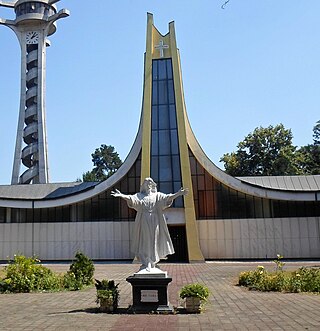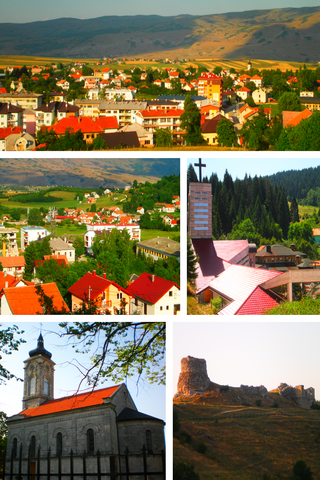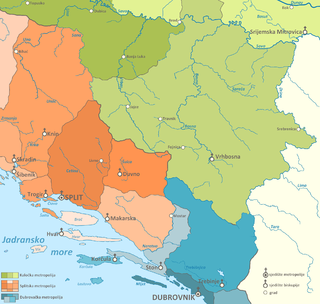
Canton 10, is one of the ten cantons of the Federation of Bosnia and Herzegovina, a political entity of Bosnia and Herzegovina. It is the largest canton by area and eighth by population. The local government seat is in Livno, while the assembly is in Tomislavgrad. It is divided into five municipalities: Bosansko Grahovo, Drvar, Glamoč, Kupres, Tomislavgrad and one city, Livno.

Tomislavgrad, also known by its former name Duvno, is a town and the seat of the Municipality of Tomislavgrad in Canton 10 of the Federation of Bosnia and Herzegovina, an entity of Bosnia and Herzegovina. As of 2013, it has a population of 33,032 inhabitants.

Livno is a city and the administrative center of Canton 10 of the Federation of Bosnia and Herzegovina, an entity of Bosnia and Herzegovina. It is situated on the river Bistrica in the southeastern edge of the Livno Field at the foot of Kruzi plateau which are located beneath the Cincar mountain and rocky hill Crvenice. Livno is the centre of the Canton 10 which mainly covers an area of the historical and geographical region of Tropolje. As of 2013, it has a population of 37,487 inhabitants. The town, with its historic ruins and old town from the 9th century, was first mentioned in 892, developing at the crossroads between the Adriatic coast and inland, i.e., regions of Bosnia, Dalmatia, Herzegovina, and Krajina.

The Catholic Church in Bosnia and Herzegovina is a part of the worldwide Catholic Church under the spiritual leadership of the pope in Rome.

The Diocese of Banja Luka is a Latin Church diocese of the Catholic Church in western Bosnia. The diocese is centred in the city of Banja Luka, Bosnia and Herzegovina.

The Diocese of Mostar-Duvno is a Latin Church diocese of the Catholic Church in Bosnia and Herzegovina. It encompasses northern Herzegovina. The episcopal seat is in Mostar, Bosnia and Herzegovina. It was formed on 5 July 1881, when the Apostolic Vicariate of Herzegovina was elevated to the diocese. It is the largest Catholic diocese in Bosnia and Herzegovina by the number of Catholics.

Kreševo is a town and municipality located in Central Bosnia Canton of the Federation of Bosnia and Herzegovina, an entity of Bosnia and Herzegovina. Kreševo is a mountainous town, located in a narrow valley of the Kreševka river, under the slopes of Mount Bitovnje. An old Franciscan monastery of St. Catharine is located in the town's outskirts.

Glamoč is a town and the seat of the Municipality of Glamoč in Canton 10 of the Federation of Bosnia and Herzegovina, an entity of Bosnia and Herzegovina. It is situated in southwestern Bosnia and Herzegovina, at the foothills of Staretina and Velika Golija mountains, and on the edge of the central part of the Glamočko Polje.

The area of today's Visoko is considered to be a nucleus from where Bosnian statehood was developed in 10th century. The expanded valley of the river Bosna around today's Visoko was the biggest agriculture area in central Bosnia, so fertile ground around Visoko was ideal for development of early political center of Bosnian nobility.

The Croats of Bosnia and Herzegovina, often referred to as Bosnian Croats or Herzegovinian Croats, are native and the third most populous ethnic group in Bosnia and Herzegovina, after Bosniaks and Serbs, and are one of the constitutive nations of Bosnia and Herzegovina. Croats of Bosnia and Herzegovina have made significant contributions to the culture of Bosnia and Herzegovina. Most Croats declare themselves Catholics and speakers of the Croatian language.

Franciscan Province of Bosna Srebrena is a province of the Franciscan order of the Catholic Church in Bosnia and Herzegovina, historically active in Croatia as well. Their headquarters are currently in Sarajevo.

Vrbica is a village in the city of Livno in Canton 10, the Federation of Bosnia and Herzegovina, Bosnia and Herzegovina.

Various monasteries and other religious houses have existed at various times during the Middle Ages in the city of Exeter, Devon, England.

Franciscan monastery of Saint Luke is a Franciscan monastery in Jajce, Bosnia and Herzegovina. The construction began in 1877 and finished in 1885. In 1934-1935 the monastery was renovated by Karel Pařík. Franciscans in the 1970s tried to return the bones of St. Luke in Jajce, and since then the monastery carries the name of this evangelist.

Franciscan friary of the Assumption of the Blessed Virgin Mary is a friary of the Franciscan Province of Herzegovina in Široki Brijeg. The friary church was built in 1905 and the friary in 1846. A much older and smaller church was built in 1847 and was demolished in 1905, in order to be replaced by a larger church. The friary is the first Franciscan friary built in Herzegovina after the Ottomans destroyed all of the monasteries there in the 16th century.

Fra Augustin Miletić (1763–1831) was a Bosnian Franciscan and prelate of the Catholic Church who served as the apostolic vicar of Bosnia from 1813 to his death in 1831.

The Diocese of Duvno was a Latin rite particular church of the Catholic Church that was established in the 14th century with a seat in present-day Tomislavgrad in Bosnia and Herzegovina. It was a suffragan diocese of the Archdiocese of Split, and during the 17th century of the Archdiocese of Dubrovnik. The diocese consisted of four parishes: Roško Polje, Duvno, Posušje and Rama.
Apostolic Vicariate of Herzegovina was an apostolic vicariate of the Catholic Church in the Ottoman Herzegovina that existed between 1846 and 1881, when it was abolished with the Diocese of Mostar-Duvno established on its place.
Peregrin Saxon, also called Peregrin of Saxony, was the first vicar of Bosnia, later becoming Archbishop-elect of Split and Bishop of Bosnia.

Kraljeva Sutjeska is a village in the municipality of Kakanj, Bosnia and Herzegovina. The village has historical significance and rich heritage, and during the Middle Ages it used to be a capital of medieval Bosnian state.


















